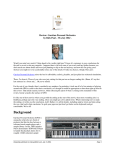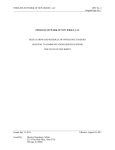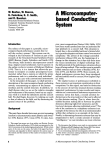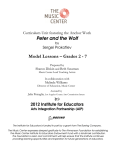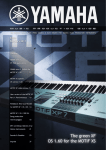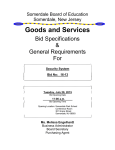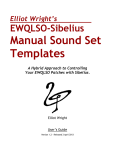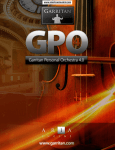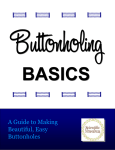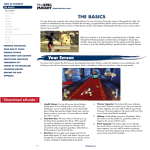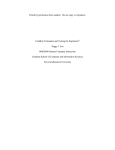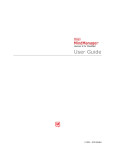Download to the 2014-2015 Teacher Student Guide
Transcript
Classroom Guide 2014-2015 Teacher’s Manual © 2014 Symphony in C Dear Teachers, Thank you for participating in Symphony in C’s 2014-2015 educational programming. The Concerts for Young People will be held on Thursday, February 26, 2015 at 10:00 and 11:30 am at the Scottish Rite Auditorium in Collingswood, NJ. In addition to the annual Concerts for Young People, Symphony in C offers the Classroom Symphony that is a series of four workshops that combine literature and music, introducing elementary-school students to the four sections of the orchestra. Additionally, students will learn about the basics of music, concert etiquette, and how to listen to and appreciate classical music. Classroom Symphony succeeds because of the active participation of teachers in preparing their students for each workshop. This includes two elements. First, we’d like all teachers to prepare their students for the workshop by teaching this guide and associated literature ahead of time in order to familiarize the students with the instruments and concepts that will be demonstrated at the workshop. Second, it is equally important that teachers assist their students in creating multi-disciplinary projects that may be shared at the conclusion of each workshop. The activity suggestions in this workbook are merely a guide for you. We encourage you to be as creative as possible in adapting this curriculum to your own classroom! This curriculum has been designed so that teachers without musical knowledge or access to a music teacher can feel comfortable teaching the material to their students. If you have questions, comments or suggestions for improving the manual, please contact the Symphony in C office. Sincerely, Symphony in C PO Box 8610 Collingswood, NJ 08108 (856) 963-6683 2 TABLE OF CONTENTS Introduction………………………………………………2 Music basics……………………………………………..4 Reading and writing music……………………………..8 The orchestra…………………………………………...15 Instrument families……………………………………..17 o Strings…………………………………………….17 o Woodwinds……………………………………….20 o Brass………………………………………………21 o Percussion………………………………………..22 The conductor…………………………………………..25 The audience…………………………………………...26 o Concert etiquette………………………………...26 o Listening guide…………………………………...28 Glossary………………………………………………….29 References and resources……………………………..34 About Symphony in C…………………………………..34 Further opportunities……………………………………35 * Please photocopy and distribute to students all relevant sections of the teacher study guide. ** For classes that are not able to go through the entire curriculum before attending a concert, teaching the concert etiquette section and listening guide is essential so that the students get the most out of their concert experience. Each section is fairly self-contained, so teachers can feel free to skip around to meet each class’ needs. *** All terms defined in the glossary are italicized in the text of each section. 3 MUSIC BASICS Rhythm: Rhythm has several components. The first is the steady beat of the music. Most people will naturally pick up on the beat—listen to any piece of music and start clapping your hands steadily along with it, or tapping your toe. This is the beat or pulse. The speed of the beat is called the tempo. Activity 1: Turn on music in the classroom, either from a radio, computer, CD player or any other setup you may have. Begin clapping to the beat and ask your students to clap along with you. The second component of rhythm is how many beats each note takes up. Some notes are one beat long, others take more than one beat and some notes only last for part of a beat. Composers vary the duration or length of notes in order to produce an interesting piece of music. These combinations of note length create different feelings in the listener and move the music along. if Activity 2: Carefully listening to the music, ask the students to see they can hear notes of different durations. Ask them to find and sing a short passage from the song that includes notes that are longer than one beat, the same length as a beat and shorter than a beat. Rhythm is regulated by the meter. Written music is divided into measures (see included example of sheet music). The meter signifies how many beats are in each measure and which types of notes get one beat. The meter is symbolized by the time signature at the beginning of each piece of music (see labeled sheet music).1 Activity 3: Complete the worksheet for some fun with rhythm and fractions! There is more information about meter and time signatures in the “Reading and Writing Music” section. 1 4 Melody: The melody is commonly referred to as the “tune.” It is the part of the music you would sing if you were trying to sing along. Activity 4: Ask the students to sing part of one of the songs you were just listening to. When you are finished, discuss which part of the music they chose to sing, and which parts they left out. For example, when singing the national anthem, everyone sings the melody to the words “Oh, say can you see…” and so forth. Nobody tries to sing the drum part! Then explain that the part they chose to sing is the melody. Melody has several components. Pitch is how high or low a note is. Pitch is what transforms a rhythm into a melody! Some instruments can produce a pitch (strings, woodwinds, brass, some percussion) but some instruments cannot (other forms of percussion). Activity 5: Choose a well-known song such as “Happy Birthday.” Ask the students to clap the rhythm of the song (i.e. “Happy birthday to you” transforms to a clapped rhythm something like “short short long long long long,” etc.). Then ask them to hum the song and explain that apart from how they are physically making the sound, the only difference between the clapped version and the hummed version is the addition of pitch. Interval refers to the distance between pitches. When a melody moves by smaller intervals, it can produce a beautiful flowing line or a scale. When it moves by larger intervals, it can be quite dramatic. Activity 6: Go through this exercise with your students, singing as necessary. In the song “Happy Birthday,” the intervals are quite small in the beginning. Think about the first two lines: “Happy birthday to you/Happy birthday to you.” By the third line (“Happy birthday, dear ___”), the pitches between the last syllable of “happy” and the first syllable of “birthday” are quite far apart, creating a dramatic effect before the most important part of the song (whose birthday it is). The last line just repeats the same idea we have heard before (“Happy birthday to you” again) and so the intervals are small. Ask the students to think of examples of songs they may know where different sizes of intervals are used, and discuss the emotional effect this has on the listener. 5 Harmony: Harmony is what happens when two or more pitches are played at the same time. An interval is two pitches played at once, or one immediately following the other; a chord is three or more pitches played at once. A chord with exactly three pitches in it (which have a specific relationship to each other) is called a triad, which is the basis of Western (European and North American) classical music. Activity 7: If you have access to a piano, try to play these chords and intervals: F+A, F+C, F+A+C, A+C#+E. If not, just show pictures to students. F A C/C#2 E Any harmony that “sounds good” is called a consonance or consonant; any harmony that “sounds bad” is called a dissonance or dissonant. Music theorists have a more technical way to determine consonance and dissonance, but how nice the harmony sounds is a good rule of thumb. Activity 8 (only if you have access to a piano or keyboard): Play various combinations of notes—some that are right next to each other, others that are farther apart. Which combinations sound good (consonant)? Which sound bad (dissonant)? C D E F G A B C Chords that sound “sad” are called minor chords; chords that sound “happy” are called major chords. Again, there are more-technical ways to determine this, but the “mood” of the chord is a good rule of thumb. 2 The C is the white key above the letter; the C# (C-sharp) is the black key immediately to the right. 6 Activity 9: Ask students to sing “Happy Birthday,” “Mary Had a Little Lamb” or another bright, cheerful song. Then ask them to sing the Christmas carol “We Three Kings” or any sad-sounding pop song. Describe to students that every piece of music is built on a system of related chords and that their happy song example is most likely built on major chords, whereas their sad song example is most likely built on minor chords. Tone color: Tone color or timbre describes the unique qualities of the sound each instrument makes. It is difficult to define but very easy to understand. Timbre is what makes all string instruments have a distinct sound in common, what makes brass instruments brassy and what makes it easy to tell just by listening that a flute and a piccolo are cousins. Activity 10 (perhaps best done after listening to some recordings, after the musicians visit the classroom or if students have some familiarity with orchestral instruments already; or ask students what their favorite instrument is and go from there): List three or four adjectives to describe the unique sound of each instrument or instrument family. If each instrument family were a smell, what would they smell like? What kind of food would each instrument family be? If you had to make a painting based on each group’s timbre, what colors would you use? And so forth— be creative! A painting by 20th-century Russian artist Wassily Kandinsky, who used to paint the images he saw while listening to music. 7 READING AND WRITING MUSIC How are orchestras today able to play music that was written decades or even hundreds of years ago? Over time, a system of accurately writing down all of the elements of music, from rhythm to pitch to harmony to how loud, soft or fast to play the music, has developed. We call this notation. The primary element of notation is called the staff. staff When discussing two or more staffs, we use the word staves. A single staff has five lines; a grand staff, usually used for piano music, has two staves joined by a curlicue bracket. grand staff (with notes) It would be impossible to know where to put each note on the staff without the help of a clef. There are four major clefs: the treble or G clef the alto/tenor or C clef the bass or F clef Here are all four clefs shown together on one staff (note that the alto and tenor clefs look the same, but are positioned differently on the staff): 8 Activity 11: Have students practice drawing each clef on a piece of paper, the chalkboard, or whatever works best in your classroom. See included worksheet for staff paper that is easy to photocopy and distribute. Note: sheet music uses different clefs for different instruments because each clef only works for a specific range of pitches. The treble clef is the highest; the alto and tenor clefs denote a middle range; the bass clef has the lowest range. The key signature is written next to the clef on each staff. The key signature can either be made up of sharps or flats (but never both together). a note with a sharp a note with a flat Sharps, flats, and another symbol, the natural, are called accidentals. Normally the notes of the scale are spaced apart by given intervals, but sharps raise the pitch of the note (up to the next piano key to the right) and flats lower the pitch of the note (down to the next piano key to the left). The key signature makes the sharps or flats it contains automatic throughout a piece of music. Naturals are used to return a note to its “standard” pitch (the white keys on the piano). a note with a natural a C major scale (no sharps or flats in the key signature) written out: C D E F G A B C B A G F E D C 9 a C major scale labeled on the notes of the piano: C D E F G A B C (go up and then back down) Sharps and flats can never be mixed in a key signature, and key signatures have a specific order of sharps and flats (i.e. F# always comes before C#). Each combination of sharps or flats is associated with a specific major and minor key— one sharp (always F#) is G major or E minor; one flat (always Bþ) is F major and D minor, and so forth. There is a system for determining what key a piece is in based on its key signature and the note or chord it ends on. Activity 12 (best for older students): Two notes that have the same pitch (i.e. are the same key on the piano) can sometimes have different names. For example, A-flat (the black key to the left of A) is the same as G-sharp (the black key to the right of G)—the black key is between G and A and therefore has different names depending on the context. This is called “enharmonic equivalency.” Have the students complete the worksheet of enharmonic equivalents with the aid of their keyboard cheat sheet. The time signature, which denotes the meter, is found to the right of the key signature. The time signature only appears at the beginning of the piece unless the composer changes it partway through, while the key signature appears on every line. The time signature is usually written as one number stacked on top of the other; the top number is the number of beats per measure and the bottom number is the type of note that gets one beat. time signature bar line clef key signature 10 Bar lines (see labeled sheet music above) are used to visually break up measures, making sheet music easier to read. A double bar is used to break up different sections of music (for example, if the composer is changing a key signature or changing tempo). A repeat sign is used to tell musicians to play an entire section again. A music end bar line lets musicians know when the piece is finished. music end double bar repeat signs (note: the exact symbol in reverse is found at the beginning of the repeated section) Here is a chart of common time signatures: 4/4 (c is a shorthand for 4/4): four beats to the measure, the quarter note gets one beat 2/2 (¢ is a shorthand for 2/2): two beats to the measure, the half note gets one beat 2/4: two beats to the measure, the quarter note gets one beat 3/4: three beats to the measure, the quarter note gets one beat 6/8: six beats to the measure, the eighth note gets one beat (sometimes played as two beats with three eighth notes per beat) 11 Notes are the most important part of sheet music! You have probably seen notes before. Notes signify two things: pitch and duration. The pitch is based on where on the staff the note head (the round part) is placed. If you remember from before, the clef assigns a certain pitch to each line and space on the staff. The combination of clef, note head and key signature allows the musician to figure out the pitch. What the note looks like determines its duration. The stem and note head combine to denote the length of the note. An empty note head is longer than a filled-in note head, and the beams or flags on the stems make a note shorter. A dot placed to the right of a note head makes it half again as long (i.e. a dotted half-note equals three quarter notes instead of two). stem note head dotted quarter note (1 ½ beats) whole note (4 beats) quarter note (1 beat) eighth notes (1/2 beat) half note (two beats) (written as interval) 12 beamed eighth notes flagged eighth note Rests let a musician know when NOT to play. They symbolize a given length of silence in the music. Dots apply to rests the same way they apply to notes. When a musician must rest for a long period of time (usually over four measures) the rest is written out differently (see graphic). The music is marked tacet (a Latin term) when a musician is supposed to rest for an entire movement or an extremely long period of time. 4+ measures half note whole note 2 measures quarter note eighth note sixteenth note Articulation is a more subtle way that a musician can change how a note sounds. Articulation has to do with how the notes are played, and how they are separated. Notes can be very distinct from one another, or they can run into each other so that it is very difficult to tell where one note ends and another begins. String instruments accomplish articulation with their bows, while woodwinds and brass articulate with their breath. Percussionists articulate based on the mallet they use and how hard they hit their instruments. markings that determine how short or long to play a note (shortest-longest, leftright) 13 long, flowing slightly separated short, separated very separated Dynamics tell a musician how loud or soft to play the music. Much of the excitement and suspense in music comes from dynamic changes. Different dynamics give a piece lots of expressive power and can really change the way a listener perceives any given melody. piano mezzo piano mezzo forte forte (soft) (medium soft) (medium loud) (loud) A crescendo indicates a gradual increase in volume, whereas a decrescendo indicates a gradual decrease. crescendo decrescendo These are the basic dynamics, although there are many more! The tempo determines how fast or slow the orchestra plays the music. Like dynamics, the tempo changes the character of the music. Here are some common tempi: Prestissimo: extremely fast Vivacissimo: very fast and lively Presto: very fast Vivace: lively and fast Allegro: fast and bright Allegro moderato: moderately quick Allegretto: moderately fast Allegretto grazioso: moderately fast and with grace Moderato: moderately Andantino: either slightly faster or slower than andante Andante: at a walking pace 14 Tranquillo: tranquil Adagio: slow and stately Grave: slow and solemn Larghetto: broadly Largo, lento: very slow There are other words that composers use (such as “molto,” very, or “espressivo,” expressive) to clarify exactly how they want the piece played. Activity 13: Have students walk around the room at the speed of various tempi, trying to do it in the style of various articulation markings and at certain dynamics. For example, doing a legato, mezzo-piano walk at an adagio speed would probably look like walking slowly, fluidly and quietly on one’s tiptoes, whereas a staccato, presto, forte walk would look like rapid, bouncy running around the room. Use the columns provided on the worksheet so that students can mix and match terms to come up with their own style of musical walking. INSTRUMENTS AND THE ORCHESTRA The Orchestra An orchestra is a large instrumental ensemble that includes members of each of the four instrument families. Some instruments are always included and others are only used sometimes. Most orchestras are led by a conductor, who doesn’t play an instrument but instead stands on the podium and directs the musicians with a baton. Larger orchestras are called symphonies or philharmonic orchestras while smaller orchestras are called chamber orchestras. Unless the orchestra is performing with a choir, the music it plays doesn’t have words or lyrics. This is called instrumental music. Orchestras began in the 1400’s in the households of European nobility (kings, queens, and other rulers), who employed musicians mainly to provide dance music for parties and balls. As theatre, ballet and opera developed, musicians began to play together in groups to accompany the performance. Nobles began to hire composers to write music for their musicians. The nobility began to build large houses in the country, where they would hire a permanent group of musicians to play music for them. Talented solo performers would also write their own compositions, featuring their instrument, and travel from country house to country house to perform with orchestras. Composers would also sometimes need to get their own groups of musicians together to perform a new work. 15 By the 1800’s, European and American cities and towns began to form community orchestras, which have since developed into the high-quality orchestras we see today around the world. These orchestras have a consistent group of musicians, generally with a few rotating conductors, that perform many concerts each year and also do many community outreach and educational activities, as well as make recordings. Symphony in C 16 The string family String instruments are made of wood and have a standard, easily-recognizable shape. They have four strings made out of metal wrapped around a core of synthetic material or gut from an animal. Before modern technology made it easier to make synthetic and metal strings, all strings were made of gut, from the intestine of a sheep, cat or other animal. String instruments produce sound when the musician moves the bow across the strings. The bow consists of a long stick of wood with horsehair attached to it, and musicians use rosin, dried pine tree sap, to make the bow hair grip the strings better and produce a stronger sound. The instruments of a string quartet: a cello (the largest), a viola (the next largest), and two violins (the smallest) The string family has four standard orchestral members and two that are sometimes included: The violin is the smallest, highest-pitched member of the string family, with a brilliant sound. It is held underneath the chin and usually plays a solo or melody part. The violin reads music written in the treble clef and can play a very high range of notes. Every orchestra has two sections of violins: the first violins, which tend to play the melody and are led by the concertmaster, and the second violins, which play more of an accompanying part. The viola is also held underneath the chin but is larger and lower-pitched than the violin with a richer, mellower sound. It reads music written in the 17 alto clef and plays a middle range of notes. Each orchestra has one section of violas which also play a harmony part most of the time. The cello is held between the legs and is larger and lower-pitched than both the violin and the viola. It usually reads music written in the tenor clef and plays a low range of notes. The cello has a full, deep sound and usually plays either a deep accompanying part or a beautiful low melody. The bass is held upright and is extremely large and deep. It reads music written in the bass clef and plays a low range of notes. The bass has a very low, powerful sound and plays the “bass line” that is the foundation for the other parts in A jazz bassist the orchestra. The bass is also very common in jazz. The harp and piano are sometimes classified as string instruments and are often found in orchestral music. However, a harp’s strings are plucked by the fingers of the musician playing it and a piano’s are hit with felt hammers that are triggered when the musician touches its keys. Guitars are also plucked string instruments but are less-commonly found in the orchestra. guitar harp piano String instruments can create many “special effects” which add interest to the music. Col legno means “on the stick” in Italian (the language most musical terms are in). While string instruments usually play with the hair of the bow, the stick can create a mechanical, tapping sound. Con sordino means “with mute” in Italian and refers to the placement of a rubber, metal or wood mute (most often rubber) on the top of the bridge to 18 keep it from vibrating too much. This makes the sound quieter and mellower. Pizzicato means “plucked” in Italian and instructs the musician to pluck the strings, usually with the right hand, instead of using the bow (see the picture of the jazz bassist above). Tremolo means “shaken” in Italian. The musician shakes the bow very lightly and quickly on the string, producing an eerie, violin with rubber shivering quality. orchestral mute Harmonics are produced by lightly placing a finger on the string in a particular spot, as opposed to pressing down on the fingerboard, and then playing the string with the bow as usual. The resulting sound is similar to a whistle. The violin. The viola has all of the same parts, but is larger; the bass and cello are similar but lack a chinrest and instead have an endpin, which allows the instrument to balance on the floor. Most adult-size instruments will only have fine tuners on the highest strings (the strings toward the bottom of the diagram). Finally, the bow is composed of a wooden stick, tightly stretched horsehair and a mechanical assembly called the frog that weights the bow and allows the hair to be tightened or loosened to the musician’s preference. 19 The woodwind family Woodwind or wind instruments are made of wood or metal and are played by blowing air against or into a hole in the instrument. Musicians can vary the pitch by pressing different combinations of keys along the body of the instrument. The woodwind-family members represented in the orchestra vary more than the strings, depending on the piece the orchestra is playing. Here are some common wind instruments: The clarinet is a reed instrument that is played in a vertical position. A thin piece of cane or plastic is fixed inside the mouthpiece, and as the air passes between them, sound is produced. This is characteristic of the single-reed family as sound is produced with the use of only one reed. There are many keys along the body of the clarinet, and the musician must press them in particular combinations to produce the desired note. The clarinet is a very important jazz instrument. The oboe is also a reed instrument, but it uses two reeds to clarinet produce sound, making it a member of the double-reed family. The air passes between the reeds into the body of the oboe to produce the sound. Like the clarinet, there are keys along the body of the oboe that the musician must press a certain way to produce a particular note. The English horn and the bassoon are larger, deeper cousins of oboe the oboe and are also played with a double reed. All three instruments are played vertically. The flute is held sideways and does not have a reed. It is usually made out of metal and is played by blowing across the top of a hole to force air through the body of the flute while, like the other wind instruments, the musician presses certain combinations of keys to get the desired note. The piccolo is a smaller, higher-pitched flute. flute piccolo English horn bassoon (2 views) *Note: images not to scale 20 The flute, clarinet and oboe have a similar range to the violin and often play melodic lines within the orchestra. The English horn and bassoon tend to play more of an accompanying part, while the piccolo is only used for special emphasis. Wind instruments can also create special effects: Flutter tonguing is when the musician makes a similar motion to rolling your r’s as if you were speaking Spanish, while playing. This sounds like a buzzing bug. A trill is when the musician alternates rapidly between two adjacent notes, sounding almost birdlike. The brass family Brass instruments are made of metal and are played by blowing air through one’s lips against a mouthpiece. The musician must press keys and valves in different combinations to produce different notes. Like the woodwinds, the brass instruments that appear in the orchestra at any given time can vary. Here are some commonly-used brass instruments: The trumpet is one of the best-known brass instruments. It is the highest-pitched instrument of the family and, along with the flute and violin, is often used for solo parts. The trumpet’s pitch is changed by pressing different combinations of three keys on the top of the trumpet instrument. The trumpet is also a very important jazz instrument. The French horn has a mellow tone and the largest range (almost four octaves) of all the brass instruments. It has a large bell into which the player can insert his or her hand to change the pitch. Most of the time, players change the horn’s pitch by opening and closing different valves along the body of the instrument. The French horn is also often used for French horn solo parts. The trombone somewhat resembles a trumpet but is much larger and deeper. Instead of pressing keys or valves to change the pitch, the trombone has a large slide that the player moves back and forth. The trombone is another common jazz instrument. trombone 21 The tuba is one of the newest members of the symphony orchestra, introduced in the mid-1800’s. It has the lowest range of the brass instruments and supplies the bass line. It is held on the lap and, like the other brass instruments, is played by blowing through a mouthpiece and pressing various combinations of keys and valves. tuba Brass instruments have a very distinct timbre from strings and woodwinds and are often used to create a marching, warlike or noble feeling in the music. Individual brass instruments are much louder than individual winds or strings, which is why the brass section is typically much smaller than the strings section. Brass instruments can create special effects: A brass player can insert a mute into the bell of the instrument in order to produce a quieter or distorted sound. Brass players can also produce a vibrato sound similar to the sound produced on string instruments by blowing into the instrument in the appropriate way. Brass players use a tongue motion called trumpet with different mutes flutter tonguing to produce a buzzing sound. Woodwinds also use this technique. The percussion family Percussion instruments produce sound by being hit, shaken, rubbed or scraped. They are mostly used to keep the rhythm or beat in an orchestra. A few percussion instruments, such as timpani, chimes, or the xylophone, can produce a pitch, but most do not. The percussion family can be divided into smaller families of instruments: Drums o Snare drums (at right) produce a rattling sound when played. Thin wires are located underneath the drum head (the skin-type part of the drum) that rattle when the drum is struck. o Bass drums are the lowest-sounding drums in the orchestra. This instrument is played upright and produces a low, deep booming that sounds like thunder. 22 o Timpani, or kettledrums, are similar to other drums in that they have a drum head or “skin” stretched over a rounded bass drum frame. Unlike other drums, the percussionist can change the tension of the skin to play various pitches. Usually a timpanist plays with a set of two to four drums of different sizes to sound different pitches. o Tambourines are very small drums that often have jingles attached to the rim. Percussionists shake or strike the tambourine with the hand in timpani order to play it. Mallet instruments can generally produce various pitches. Their sound varies depending on the material the mallet is made from. Mallets can be metal, wood, rubber, or even yarn. Metal, wood and hard rubber mallets will produce a sharp sound, whereas soft rubber and yarn mallets will produce a softer, mellow sound. o Tubular bells are large sets of pipes of varying sizes that often sound like church bells. o Glockenspiel literally means to play (“spiel”) the bells (“glocken”) in German. The bars are set up similarly to the keyboard of a piano and are made of metal. The tambourine glockenspiel is most commonly played with metal or rubber mallets. o A xylophone is a set of wooden or plastic blocks that vary in size and are arranged similarly to the glockenspiel. The xylophone produces a very high-pitched, piercing glockenspiel sound that can be heard above the entire orchestra. It is usually played with rubber or yarn mallets. o The marimba is similar to the xylophone, but it has many more blocks that can be struck, making it longer than any of the other mallet instruments. The marimba has resonators underneath the blocks that are made of gourd or metal. The marimba must always 23 be played with yarn mallets, as the wooden blocks are very thin and could be broken or chipped with a metal or rubber mallet. Auxiliary percussion or toys are instruments that are not typically used but can produce a sound that fits in with the music. These can range from actual instruments to common objects. o Crash cymbals are large metal disks that the musician bangs together for special effect. They are very loud and dramatic! o Finger cymbals are small versions of crash cymbals and produce a mysterious ringing sound because of their size. o The triangle is a small piece of metal bent into a triangle shape that produces a “ting” sound when struck with another metal piece. crash cymbals o Claves are thick sticks made of rosewood. The percussionist holds one of the claves in one hand and taps it with the clave in the other hand. This produces a triangle severe, precise sound that is often heard in Latin music. o Temple blocks are a set of hollow wooden boxes that vary in size, usually arranged from largest, or lowest-sounding, to smallest, or highest-sounding. They have a hollow, echoing sound. o Maracas are Latin American instruments that are usually played in pairs, with one in each hand. Seeds or beads are placed inside an oval-shaped container that is made of gourd or metal, then held by the handle and shaken to produce a rattling sound. maracas 24 The conductor At the most basic level, the conductor is a person who stands in front of the orchestra on a podium and makes specific hand motions or waves a baton to keep the orchestra together and direct the musicians in their interpretation of the music, both in performances and rehearsals. For example, a conductor must both keep a steady beat while signaling a tempo change or the dynamics of the music. In large modern orchestras, a conductor is often called a music director and not only leads the orchestra while it’s playing but creates the concert programs for the year, works with the business side of the orchestra to do public outreach, and sometimes compose or perform themselves. Rossen Milanov, conductor of Symphony in C Here are some examples of common conducting patterns. Most standard meters or time signatures have their own conducting pattern. a conducting baton Activity 14: Have students imitate conducting patterns (also found on included worksheet). 4/4 time 2/4 time 3/4 time 6/8 time 25 THE AUDIENCE Concert etiquette Before the concert o When you are going to a professional orchestra’s concert, you should try to look nice. There is no need to be extra fancy, but in a concert hall you should dress like you are attending a religious service, going out to a pretty nice restaurant, or getting your school picture taken. Sometimes orchestras play outdoor concerts in parks in the summertime, and for those you can just wear normal clothes. o It is almost always necessary to buy tickets ahead of time for a classical concert. However, most orchestras offer student tickets at a substantial discount (usually under $10, even at the biggest orchestras). If there is a concert you want to go see and regular tickets look too expensive, you should call the box office (or check on the orchestra’s web site) and ask if they have student-price tickets. o It is very important to arrive on time. “On time” in classical music means “a little bit early”—you should plan on getting to the concert hall about 20 minutes before the show starts so you can find your seat, get a program, and settle in. If you are late, the ushers will not let you sit down until the next piece starts or even until intermission (the break halfway through the concert) so that you don’t disrupt the show as you sit down. Therefore, if you’re late you might miss a lot of the concert! Arriving at the concert o Do not bring food or beverages into the concert hall. o Sit quietly in the seat you were assigned on your ticket. o The lights will dim when the concert is about to start. o Before the lights dim, you should turn off your cell phone, watch alarms, or anything else that could beep or make noise during the concert. It is very important to turn your phone off instead of just putting it on vibrate or silent, because cell phones send out signals even when they’re on silent that can interfere with the sound system of the concert hall. o Get a program before the performance begins so you do not have to get up or talk while the music is playing. o If you will need cough drops, make sure you unwrap them before the show! Crinkly wrappers are very annoying to other people trying to listen. o Make sure that you are comfortable in your seat so that you do not have to move around unnecessarily. 26 o If you have forgotten to do any of these things before the concert and you need to do them during the concert, make sure to do it between pieces. During the concert o Sit quietly and pay attention to the performance. This is the best way to enjoy the music because you can focus on all of its details, and allows those around you to enjoy the music as well. o But people also have different ways of listening, so do what works best for you as long as you are not disturbing other people. For example, some people like to close their eyes while others like to sit on the edge of their seat and watch the conductor. Some people like to focus on one instrument at a time while others like to take everything in at once. o Clap after every piece. However, if a piece has multiple movements, only clap after the whole piece is finished. For example, if the orchestra is playing a concerto with three movements and a symphony with four movements, you clap after all three movements of the concerto are done and again after all four movements of the symphony are done. Movements are often numbered in the program. If you are not sure whether to clap or not, wait a few seconds—if most other people begin to clap, join in. If not, hold still for a while longer! o If the orchestra or soloist was really great, one of the best you’ve ever heard, the audience sometimes gives a standing ovation, where everyone stands up to clap for an extended length of time. o You may leave your seat during intermission, which will be listed in your program, to use the restroom or get a snack if the concert hall has a concession stand. Try not to leave at any other time unless it is an emergency and try to leave between pieces if at all possible. After the concert o Continue to clap after the last piece until most people have finished clapping. o Wait until the lights turn on before you stand up to leave. o Wait until people between your seat and the aisle leave so that you do not push past anyone. o Exit quickly so you don’t block people behind you. 27 Listening guide Listening to a concert of classical music is not like listening to any other kind of music. It is very important to prepare yourself well to listen to classical music and to pay extra close attention during the concert. Before the concert o If you know what will be on the program, try to listen to a recording or read about the composer so you have an idea of what to expect. Information about the program can usually be found online. o Prepare yourself so you won’t be distracted during the concert. Make sure to eat before you go so you’re not hungry, get enough sleep so you’re not tired, and use the restroom before the performance. At the concert o Follow proper concert etiquette so as not to be distracted. o Pay attention to the various things going on onstage. Ask yourself: What is the conductor doing? What are the different sections doing? Is anyone playing a solo? Which instruments are playing the melody? Which instruments are playing harmony parts? How is the music changing with time? Is it getting louder, softer, faster, or slower? How is the mood changing? How is each piece different from the others? How is each movement of a piece different from the others? How does the music make you feel? Happy, sad, scared, peaceful, energetic, or any other way? Does the music make you think of a story or pictures that could go along with it? What is that story? 28 GLOSSARY Accidental: An accidental is any symbol that changes the pitch of a note from the normal pitch of the key signature. Articulation: Articulation describes how connected each note is to the notes before and after it. More generally, it describes the feel of the flow of the music. Auxiliary percussion/“toys”: Percussion instruments that are not typically used but nevertheless make sense in the context of a given piece. These can be anything from “real” instruments like triangles or finger cymbals to everyday items like trash can lids. Bar line: Bar lines are thin lines written on the staff to separate measures. They are visual cues that help musicians know where one measure ends and the next begins. Baton: A baton is a small, thin stick usually made of wood, fiberglass or carbon fiber that conductors use to lead an orchestra. It has a small knob on the bottom to make it easier to hold. However, some orchestral conductors and most choral conductors choose to conduct with their hands instead of a baton. Beam: A beam horizontally connects notes that are shorter than a quarter note to show which notes belong to the same beat. For example, two eighth notes that together make up a beat are often beamed together to clearly indicate where the beats fall. Beat: The beat is the steady pulse of the music. There are a certain number of beats per measure, as determined by the time signature. One of the main functions of a conductor is to make sure that all the musicians in the orchestra are following the same beat. Bell: A bell is a very common type of musical instrument, occasionally found in the percussion section of symphonic orchestras. “Bell” also refers to the part of a woodwind or brass instrument where the sound exits, often flared in shape and larger than the tube that makes up the body of the instrument. Bow: The bow is held in a string player’s right hand and drawn across the strings to produce a sound. It consists of a long, carefully-bent stick of wood to which tightened horsehair is attached. Musicians often rub rosin on the hair to improve the grip of the bow on the strings. Box office: The box office is the physical location, usually in the concert hall or performance venue, where people can purchase tickets. Typically, each performing arts organization or theatre runs its own box office. It is also usually possible to buy tickets online or over the phone, depending on the organization. Brass instruments: Most brass instruments are, in fact, made of brass or metal, but a brass instrument is more technically defined as an instrument that produces sound when a player blows into a mouthpiece connected to a resonating tube. Brass instruments include the trumpet, trombone, tuba and French horn. Cane: Cane is the stiff plant material out of which reeds are made. Chord: A chord is when at least three notes or pitches are sounded at the same time. There are many different types of chords, each with its own specific character. Each key signature uses a different set of chords. Clef: A clef is a symbol used to indicate the correct pitch of written notes. Depending on which clef is used and where on the staff it is placed, a note on a line is played at a specific pitch. Treble clef: The treble or G clef is used for the highest-pitched instruments. Among orchestral instruments, it is used by the violin, flute, oboe, English horn, clarinet, trumpet, and for the highest notes played by the piano, organ, harp, cello, bassoon, trombone and viola. 29 Alto clef: The alto or C clef has an upper-middle range and is used by the viola and alto trombone. Tenor clef: The tenor or C clef has a lower-middle range and is used by the bassoon, cello, double bass and trombone in their upper ranges. It is shaped exactly the same as the alto clef, as they are both C clefs, but varies only in where it is positioned on the staff. Bass clef: The bass or F clef has the lowest range and is used by the cello, bass, bassoon, contrabassoon, trombone, tuba and timpani, and for the lower range of the piano, organ and French horn. Neutral/percussion/rhythm clef: Unpitched percussion instruments use the neutral clef, often called the percussion or rhythm clef, which only shows rhythm and no pitch. Col legno: Col legno means “with the wood” in Italian. It is a string technique where the musician lightly taps the strings with the stick of the bow instead of drawing the hair across the strings. It produces a very quiet, often-spooky sound. Composer: A composer is a person who writes music. Concertmaster: The concertmaster is the first chair of the first violin section. He or she is the leader of the musicians and often works with the conductor or music director to make decisions about how to play a piece. The concertmaster will play all violin solos and comes out before every concert and rehearsal to tune the orchestra. Conductor: The conductor leads the orchestra during rehearsals and concerts. He or she uses a baton or hand gestures to show where the beat is, the tempo, and other aspects of the desired style, such as the dynamics. Each time signature has a specific conducting pattern associated with it (see the diagrams in the section on conducting). The conductor also gives cues, or an indication of when certain sections are supposed to come in. Finally, the conductor often serves as music director, making important decisions about what the orchestra will play (its repertoire), helping to create long-term business plans and acting as the public face of the orchestra. Consonance/consonant: Consonant chords or intervals, at the most basic level, are those that sound pleasant. More-technical music theory definitions have to do with which chords or intervals must be played next in order to make the piece flow logically. The opposite of dissonance or dissonant. Con sordino: Con sordino means “with mute” in Italian. Each instrument has a different type of mute, a small piece of wood, rubber or metal that is attached to the instrument in some way to stop some of its vibrations and therefore make the sound quieter. String instruments attach a small piece of rubber to the bridge; brass instruments put a device made of metal, plastic, or cardboard and cork into the bell of the instrument. Wind instruments are usually not muted. Finally, pianos have a pedal that mutes the entire instrument when it is depressed. Dissonance/dissonant: Dissonant chords or intervals, at the most basic level, are those that sound unpleasant. More-technical music theory definitions have to do with which chords or intervals must be played next in order to make the piece flow logically. The opposite of consonance or consonant. Dot: A dot increases the duration of a note by half again when it is written next to the note. For example, a half note is usually two beats, but a dotted half note is three beats. Dots are also placed above or below notes to indicate staccato or other articulation. Double bar: A double bar is used in sheet music to indicate the end of one section and the beginning of another within a piece of music. It is most often used with a major change, like a change of key signature or tempo. Drums: Drums are a type of percussion instrument that have a drum head or skin stretched across a metal, wood or plastic frame. They are played with the hands, a mallet or drumsticks. Duration: Duration refers to the length of a note or note value. 30 Dynamics: Dynamics are how loud or soft a note is played. Dynamics markings are usually written in Italian. Flag: A flag on the end of a note’s stem is the opposite of a dot—it cuts the note’s value in half. For example, a flag on a quarter note turns it into an eighth note. It looks like a squiggly line attached to the stem. Flat: A flat is an accidental that moves the pitch of a note down by a half step. Flutter tongue: Flutter tongue is a technique used by wind and brass players to create a buzzing sound. It involves rapid movement of the tongue while playing. Harmonics: Harmonics are a special effect produced by string instruments. If a string player places his or her finger on the string at very specific places without pushing down all the way, a beautiful high-pitched whistling effect is produced. Harmony: Harmony refers to the simultaneous use of various pitches and to the progression of various chords throughout a piece. Intermission: Intermission is the break in the middle of a concert. If the program is long enough, the music director will put a 10- to 15-minute break halfway through to give people a chance to stretch their legs or use the restroom. Interval: An interval is the distance or relationship between two musical notes. Key signature: The key signature is a combination of sharps or flats placed next to the clef that indicate which accidentals to play all the time. For example, the key of G major has one sharp, F sharp. This means that every F in the piece unless marked with a natural sign needs to be played as an F sharp. Keys: Keys refers to both piano and woodwind or brass keys, which the musician presses to produce a certain note. Piano keys are very recognizable, the black and white pattern on the keyboard. Brass or woodwind keys are smaller and attached to the body of the instrument. However, “key” is also used to describe the set of chords and notes that can be used in the piece. Each key has a distinct quality and can evoke very different feelings in listeners. Keys are symbolized by key signatures, each of which corresponds to both a major and minor key. Major: Major keys, chords or intervals are generally happier- and brighter-sounding than minor keys, chords or intervals. Mallet instruments: Mallet instruments are percussion instruments that are played by striking them with mallets, sticks with a yarn, rubber, metal or wood ball on the end. Measure/bar: A measure or bar is a length of time that is assigned a certain number of beats based on the time signature. They are notated by bar lines, which show where one measure ends and the next begins. Melody: The melody is the most recognizable part of a piece of music. It is the line that you would sing if you were trying to describe a piece to someone else. Meter: Meter describes the underlying rhythmic pattern of a piece of music and can be thought of as the number of beats that fit per measure. Meter is symbolized by the time signature. Minor: Minor keys, chords or intervals are generally sadder- and darker-sounding than major keys, chords or intervals. Mouthpiece: Woodwind and brass instruments, which are played by forcing air though tubing and pressing various combinations of keys, have mouthpieces where the player places his or her lips so that he or she can blow through the instrument. Music end: A music end is a double bar where the right side is thickened. Rather than denoting the end of a section, as a double bar does, the music end denotes the end of the movement or piece. 31 Mute: A mute is a device made of wood, metal, rubber, plastic, paper or cork that musicians attach to or place in or on an instrument to dampen the vibrations and make the instrument quieter. Natural: A natural is an accidental that returns a pitch from being flat or sharp back to its standard pitch. For example, a C-sharp will be returned to a C. Notation: Music notation is a system of written symbols used to represent music, which is an auditory art form. Written music is usually called sheet music. Note: A note is a sound with a pitch; the building block of music. Note head: The note head is the round part of the written note. Percussion instruments: Percussion instruments are instruments that are played by being struck or hit. These include drums, cymbals, the xylophone, and many others. Pitch: Pitch is how high or low a note is. In Western (European and American) music there are seven possible basic pitches, labeled A, B, C, D, E, F and G (combined with sharps and flats). These repeat over and over in octaves (a type of interval). Pizzicato: Pizzicato means “plucked” in Italian and is a technique for string instruments where the musician uses one or two fingers of the right hand to pluck the strings over the fingerboard (see diagram in strings section of packet). Podium: The podium is the raised platform or box on which the conductor stands onstage. This makes it easier for the musicians to see his or her motions. Principal: The leader or first chair of every section in the orchestra is called the principal. The principal lets his or her section know when to enter and directs the other musicians on certain technical matters of playing the piece, and must be in excellent communication with the conductor. The principal of the first violin section is called the concertmaster. Reed (single/double): A reed instrument is a woodwind instrument that has a piece of cane (the reed) attached to the mouthpiece. When a musician blows into the mouthpiece, the reed vibrates, helping to produce the sound of the instrument. Reed instruments can either be single reeds or double reeds (having one or two pieces of reed attached to the mouthpiece). Reeds include the clarinet, oboe, bassoon, and English horn. Rehearsal: Rehearsal is another word for practice, but it usually signifies that musicians are practicing as an ensemble. Orchestras rehearse very often and very intensely in order to play their best. Repeat sign: A repeat sign tells a musician to play a certain section again. There are usually two of them, one at the beginning of the section and one at the end. Repertoire: An orchestra’s repertoire is the set of pieces it is able to play well; this usually refers to the set of pieces the orchestra is going to play in any given season (i.e. Symphony in C’s 20082009 repertoire). Repertoire also refers to all the pieces that have been composed for a given type of ensemble or for a certain instrument (i.e. the cello repertoire). Rest: A rest is a pause in the music. Rests can be of all different lengths, from parts of beats to many measures. They are notated in sheet music Rhythm: Rhythm refers to the beat of the music and to the duration of each note played. Rosin: Rosin is hardened resin, which is secreted by pine trees. It is formed into little cakes, which string players then rub on the hair of their bows to make it grip the strings better. Scale: A scale is a set of notes in a specific key. The key (i.e. C major) determines which note the scale starts on (a C major scale would begin on C), and whether the scale is a major or minor scale is determined by the intervals between notes within the scale. Sharp: A sharp is an accidental that raises the pitch of a note by a half-step. For example, a C would be raised to a C#. 32 Sheet music/score: Sheet music is the written notation of music that musicians look at as they play to inform them how to play the piece. Sheet music that shows the parts for all instruments in a piece at the same time is called a score. Slide: The slide is the part of the trombone that the musician moves back and forth to change the pitch being played. See diagram in brass section Staff/staves/grand staff: The staff (plural, staves) is a set of five horizontal lines on which all other musical notation is arranged (i.e. the clef(s), key signature, time signature and notes). The grand staff is used for piano music and consists of two staves with some space in the middle joined together by a bracket. The upper staff shows the music that the right hand plays (usually in treble clef) and the lower staff shows the music that the left hand plays (usually in bass clef). Standing ovation: A standing ovation is when the audience is so impressed with the quality of the performance that everyone stands up to clap when it is finished. Stem: The stem is the long, thin vertical part of the written note. String instruments: String instruments are hollow wooden instruments that produce sound when a bow is drawn across long, tightened strings. String instruments include the violin (of which there are two sections in the orchestra), viola, cello, and bass. The piano and harp are sometimes included in this group, but they are played differently—the piano’s strings are hammered and the harp’s are plucked. Strings: Strings are the primary component of a string instrument. They are usually made of nylon or another synthetic material around which metal is very tightly wrapped. See the diagram in the section about string instruments. Tacet: “Tacet” is Latin for “it is silent.” It is used to indicate that an instrument or section is quiet for an extremely long time, usually for an entire movement or portion of a movement. Tempo: “Tempo” is Italian for “time” and refers to the speed of a piece of music. There are many tempo markings denoting any speed from extremely slow (“lento”) to extremely fast (“prestissimo”). Time signature: The time signature is marked at the beginning of every piece of music (or when the time signature changes) to denote the number of beats per measure and what type of note gets one beat. The time signature is written as two numbers, one stacked on top of the other; the top number is the number of beats per measure and the bottom number is the type of note that gets one beat (4=quarter note, 8=eighth note, etc.). Tone color/timbre: Tone color or timbre is the quality of sound that makes each instrument or each instrument family sound unique. It is a very hard concept to define, but most people can describe an instrument’s unique qualities very easily. Tremolo: Tremolo is when a musician, most commonly a string player, rapidly repeats a single note, usually by shaking the bow arm. Tremolo is denoted by three short, thick diagonal lines on the stem of a note (or underneath, if it’s a whole note). Triad: A triad is a chord that is made up of three distinct pitches. Triads are constructed in a particular way and the triads included in a piece influence the key it is in. Trill: A trill is a form of musical ornamentation commonly used by the piano, string and woodwind instruments. A note marked as a trill should be played as quickly alternating with the note above it. Usher: An usher is a person who takes tickets, directs people to their seats and assists with security and general operations in the concert hall. Valves: Brass instruments produce sound when a musician manipulates both keys and valves, which change the speed and direction of air flowing through the tubes of the instrument. Venue: The venue is the physical space in which the concert or performance is held. 33 Wind instruments: Though woodwinds are often referred to as wind instruments, the wind instrument family includes both woodwind and brass instruments. Woodwind instruments: Woodwinds are technically defined as any instrument that produces sound when a musician blows against an opening in or edge of the instrument, causing resonating tubes to vibrate. Woodwind instruments include the clarinet, flute, oboe, bassoon and English horn. REFERENCES AND RESOURCES Music dictionary: http://www.music.vt.edu/musicdictionary/ Musical terms and symbols o Glossary of musical terms: http://classicalworks.com/html/glossary.html o Chart and explanation of musical symbols: http://www.dolmetsch.com/musicalsymbols.htm General music theory: http://www.teoria.com/ (also available in Spanish) Fundamentals of music/music theory (more advanced): http://www.freeed.net/free-ed/Arts/Music01/lessonmain.asp “The Orchestra: A User’s Manual”: http://www.mti.dmu.ac.uk/~ahugill/manual Information about the conductor o What does a conductor do?: http://www.wisegeek.com/what-doesa-conductor-of-an-orchestra-actually-do.htm o Diagrams of conductor movements: http://www.infovisual.info/04/046_en.html Information about instruments: http://www.dsokids.com/2001/instrumentchart.htm Concert etiquette o http://musicappreciation.suite101.com/article.cfm/concertetiquette o http://www.essortment.com/all/classicalmusi_rwsl.htm How to read music: http://www.teoria.com/tutorials/reading/index.html A lot of sheet music is available online: o http://www.8notes.com/classical/ o http://www.freesheetmusicguide.com/ Classical recordings are available at most public libraries or in most bookstores (or online) 34 ABOUT SYMPHONY IN C Symphony in C, formerly the Haddonfield Symphony, is a symphony orchestra based in Camden, New Jersey. The Haddonfield Symphony, a community orchestra founded in 1952, evolved over the years into a professional development orchestra, training young musicians from the best music schools for careers in the nation’s top orchestras. Rossen Milanov is currently Symphony in C’s music director, now performing in the Gordon Theater at Rutgers-Camden Center for the Arts in Camden, NJ. Visit us online at http://www.symphonyinc.org/ ! FURTHER OPPORTUNITIES Listen to other classical music groups in the area! o The Philadelphia Orchestra o The Philadelphia Chamber Music Society o Most colleges and universities in the area have excellent orchestras (and usually offer very cheap tickets): Curtis Institute University of Pennsylvania Temple University and others. Join your school’s band, orchestra or chorus! Take private lessons! o Ask your music teacher for a recommendation. o Moorestown School of Music: (856) 235-7565 o Perkins Center for the Arts in Moorestown: (856) 235-6488 o Settlement Music School: (215) 320-2600 o Temple University Music Prep: (215) 204-1512 Join a Symphony in C’s Youth Orchestra! Held Wednesdays during the school year at the Haddonfield Center and School for the Performing Arts at Grace Church in Haddonfield. Please visit www.symphonyinc.org for more information on the Youth Orchestra. Attend Symphony in C’s Summer Camp! August 3-August 15 from 8:30 am to 12:30 pm at Rutgers University-Camden. For information please visit www.symphonyinc.org . 35



































